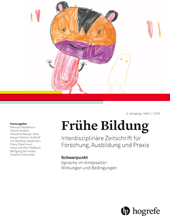Der Einfluss von Mehrsprachigkeit auf mathematische Fähigkeiten bei Grundschulkindern mit niedrigem sozioökonomischen Status
Abstract
Zusammenfassung. Viele mehrsprachige Grundschulkinder weisen unzureichende Kenntnisse in der Mehrheits- und Instruktionssprache (hier: Deutsch) auf. Dies geht häufig mit Kompetenzdefiziten in anderen akademischen Bereichen einher. Im Gegensatz dazu stehen Befunde bzgl. kognitiver Vorteile insbesondere in den exekutiven Funktionen (EF) bei bilingualen gegenüber monolingualen Kindern, die jedoch bisher vor allem für Kinder mit hohem sozioökonomischem Status (SÖS) belegt sind. In der vorliegenden Studie wurde der Einfluss von Sprachstatus (monolingual vs. bilingual), Deutschkenntnissen und SÖS auf die Leistung bei mathematischen Textaufgaben untersucht. An der Studie nahmen N = 77 Grundschulkinder aus Familien mit unterdurchschnittlichem SÖS teil. Die Ergebnisse bestätigten die Bedeutung der Kenntnisse in der Instruktionssprache Deutsch für mathematische Kompetenzen. Mehrsprachige Kinder hatten bei Mathematikaufgaben mit hohen Anforderungen an EF trotz schwächerer Sprachkenntnisse einen Vorteil gegenüber ihren einsprachigen Mitschülern.
Abstract. Many multilingual elementary students in Germany show low levels of German language proficiency. These deficits are often associated with difficulties in other academic domains. By contrast, there is evidence of cognitive advantages in multilingual children, especially regarding executive functions (EF). However, these advantages have been documented primarily for children from families with high socioeconomic status (SES). The present study investigated the influences of multilingualism, German language proficiency, and SES on solving mathematical word problems. Participants were N = 77 elementary students from families with below-average SES. Findings confirmed the importance of proficiency in the instructional language for mathematics competencies. In spite of their lower German language proficiency, multilingual children showed advantages in mathematics problems with high EF demands as compared with their monolingual peers.
Literatur
(2000). Comprehension processes in simultaneous interpreting. In A. Chesterman, N. Gallardo San Salvador & Y. Gambier (Eds.), Translation in context (pp. 127 – 142). Amsterdam: Benjamins.
(2008). Cognitive control and lexical access in younger and older bilinguals. Journal of Experimental Psychology: Learning, Memory, and Cognition , 34 , 859 – 873.
(2000). Expressive one word picture vocabulary test . London, England: Pearson Assessment. (2007). Peabody Picture Vocabulary Test ( 4th Edition ). Minneapolis, MN: NCS Pearson.
(2005). ISEI, ISCED, HOMEPOS, ESCS: Indikatoren der sozialen Herkunft bei der Quantifizierung von sozialen Disparitäten. Zeitschrift für Erziehungswissenschaft , 8 , 521 – 539.
(2005). The construction of word meaning in a multicultural classroom. Mediational tools in peer collaboration during mathematics lessons. European Journal of Psychology of Education , 20 , 45 – 59.
(2012). Bilingualism enriches the poor enhanced cognitive control in low-income minority children. Psychological Science , 23 , 1364 – 1371.
(2011). TROG-D. Test zur Überprüfung des Grammatikverständnisses ( 5. Auflage ). Idstein: Schulz-Kirchner Verlag.
(2013). Perspective-taking ability in bilingual children: Extending advantages in executive control to spatial reasoning. Cognitive Development , 28 , 41 – 50.
(2012). Zuwanderungsbezogene Disparitäten. In P. Stanat, H.-A. Pant, K. Böhme & D. Richter (Hrsg.), Kompetenzen von Schülerinnen und Schülern am Ende der vierten Jahrgangsstufe in den Fächern Deutsch und Mathematik. Ergebnisse des IQB-Ländervergleichs 2011 (S. 209 – 235). Münster: Waxmann.
(2013). Second language learners' performance in mathematics: Disentangling the effects of academic language features. Learning and Instruction , 28 , 24 – 34.
et al. (2016). Die Rolle der Sprache für zuwanderungsbezogene Ungleichheiten im Bildungserfolg. In C. Diehl, C. Hunkler & C. Kristen (Hrsg.), Ethnische Ungleichheiten im Bildungsverlauf: Mechanismen, Befunde, Debatten (S. 157 – 241). Wiesbaden: Springer VS.
(2011). Cognitive benefits and costs of bilingualism in elementary school students: The case of mathematical word problems. Journal of Educational Psychology , 103 , 547 – 561.
(2004). Deutscher Mathematiktest für zweite Klassen (DEMAT2+) . Göttingen: Hogrefe.
(2009). The contributions of working memory and executive functioning to problem solving representation and solution generation in algebraic word problems. Journal of Educational Psychology , 101 , 373 – 387.
(2016). Sprachliches Scaffolding zur Unterstützung naturwissenschaftlichen Lernens im Kindergartenalter. In E. Tschirner, O. Bärenfänger & J. Möhring (Hrsg.), Deutsch als fremde Bildungssprache: Das Spannungsfeld von Fachwissen, sprachlicher Kompetenz, Diagnostik und Didaktik (Deutsch als Fremd- und Zweitsprache, Schriften des Herder-Instituts (SHI), Bd. 7 , S. 97 – 114). Tübingen: Stauffenburg Verlag.
(2008). The development of two types of inhibitory control in monolingual and bilingual children. Bilingualism: Language and Cognition , 11 , 81 – 93.
(2000). The unity and diversity of executive functions and their contributions to complex ‘‘frontal lobe’’ tasks: A latent variable analysis. Cognitive Psychology , 41 , 49 – 100.
(2002). A situated and sociocultural perspective on bilingual mathematics learners. Mathematical Thinking and Learning , 4 , 189 – 212.
(2005). Neurocognitive correlates of socioeconomic status in kindergarten children. Developmental Science , 8 , 74 – 87.
(2002). Assessing the effects of bilingualism: A background. In D. K. Oller & R. E. Eilers (Eds.), Language and literacy in multilingual children (pp. 3 – 22). London, England: Cromwell Press.
(2013). There is no coherent evidence for a bilingual advantage in executive processing. Cognitive Psychology , 66 , 232 – 258.
(1986). Raven's coloured progressive matrices . London: Pearson Assessment.
(1997). Erwerb mathematischer Kompetenzen: Literaturüberblick. In F. E. Weinert & A. Helmke (Hrsg.), Entwicklung im Grundschulalter (S. 141 – 155). Weinheim: Beltz.
(2013). When language of instruction and language of application differ: Cognitive costs of bilingual mathematics learning. Learning and Instruction , 26 , 36 – 44.
(2008). Education policy and equality of opportunity. Kyklos , 61 , 279 – 308.
Statistisches Bundesamt (2012). Einkommen, Einnahmen und Ausgaben . Zugriff am 06.09.2014. Verfügbar unter https://www.destatis.de/DE/ZahlenFakten/GesellschaftStaat/EinkommenKonsumLebensbedingungen/EinkommenEinnahmenAusgaben/Tabellen/Haushaltsnettoeinkommen.html(1998). Die Entwicklung des mathematischen Verständnisses im Kindesalter . Berlin: Pabst Science.
(2003). Früh übt sich: Neuere Ergebnisse aus der LOGIK-Studie zum Lösen mathematischer Textaufgaben in der Grundschule. In A. Fritz., G. Ricken & P. Schmidt (Hrsg.), Handbuch Rechenschwäche. Lernwege, Schwierigkeiten und Hilfen (S. 116 – 130). Weinheim: Beltz.
(2014). Working memory and executive functions: Effects of training on academic achievement. Psychological Research , 78 , 852 – 868.



